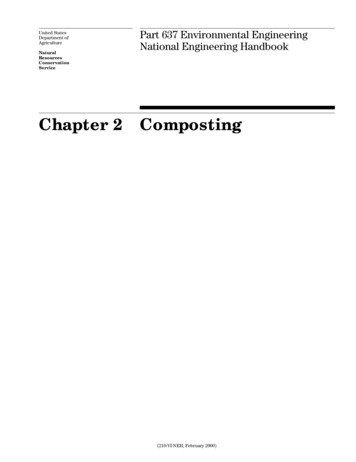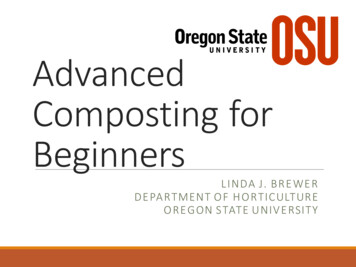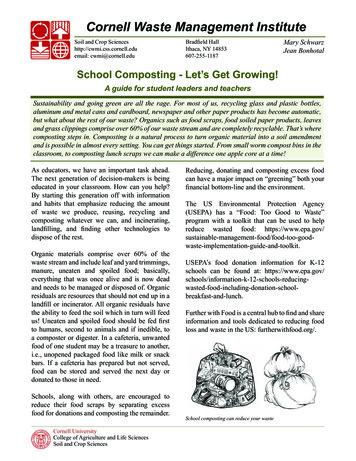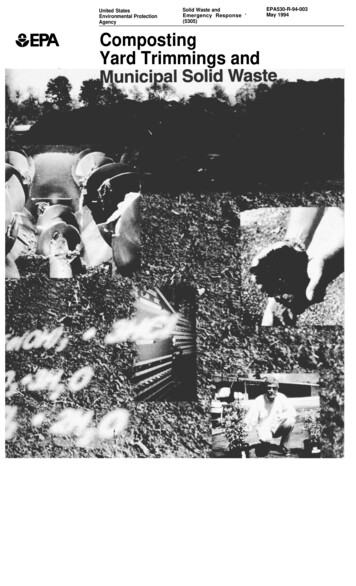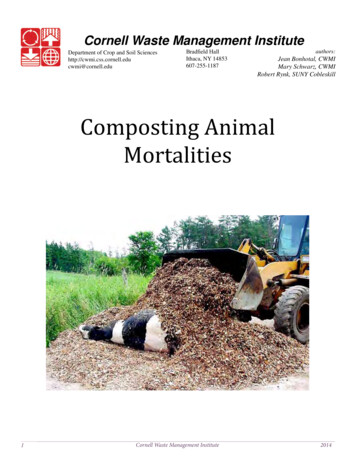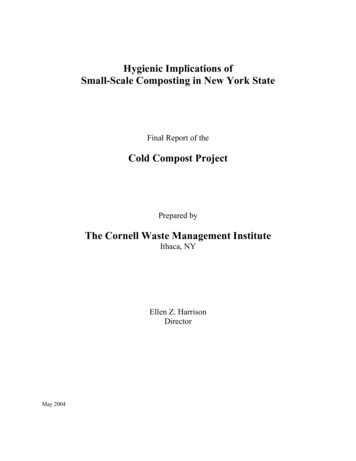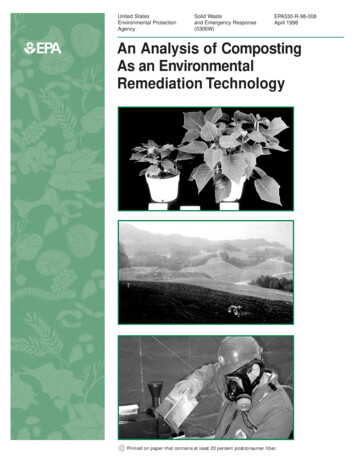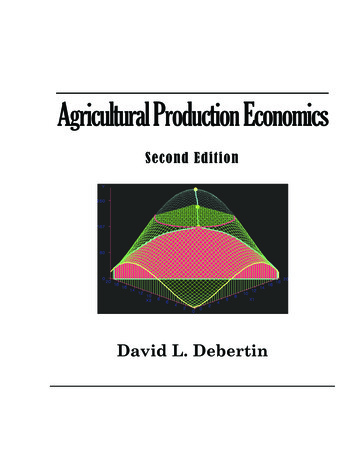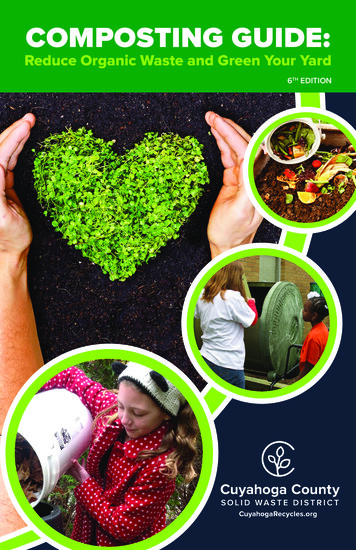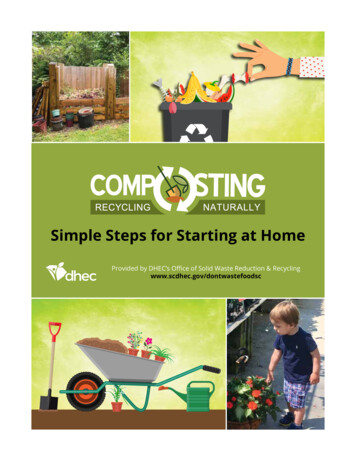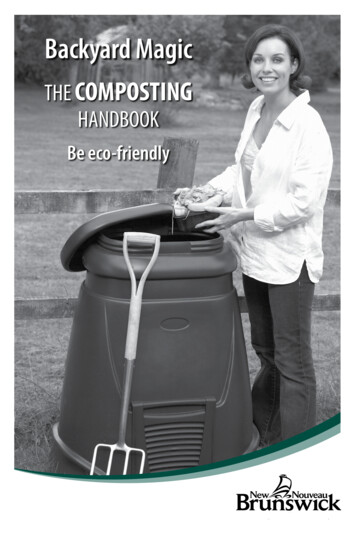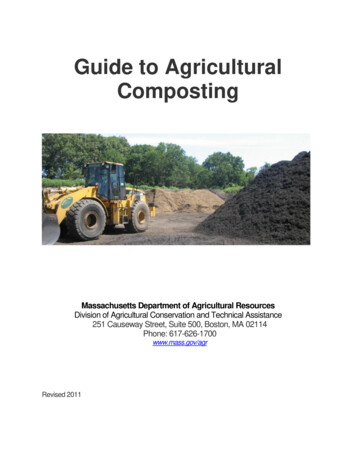
Transcription
Guide to AgriculturalCompostingMassachusetts Department of Agricultural ResourcesDivision of Agricultural Conservation and Technical Assistance251 Causeway Street, Suite 500, Boston, MA 02114Phone: 617-626-1700www.mass.gov/agrRevised 2011
AcknowledgementsThe purpose of this Guide is to encourage and safeguard agricultural composting. Towards these ends,the Massachusetts Department of Agricultural Resources (MDAR) and the Department ofEnvironmental Protection (MassDEP) have developed a regulatory framework that providesappropriate resource protection without unduly inhibiting farming activities.The guide was originally written by Sumner Martinson of MassDEP and the late Maarten van deKamp of MDAR. It has been updated in 2010 by Saiping Tso of MDAR.Much of the material presented in these guidelines was taken from the “Leaf and Yard WasteComposting Guidance Document” produced by the Massachusetts Department of EnvironmentalProtection.Massachusetts Department of Agricultural ResourcesDivision of Agricultural Conservation and Technical Assistance251 Causeway Street, Suite 500Boston, MA 02114Phone: 671-626-1700http://www.mass.gov/agr/divisions/ag technical assistance.htm.Massachusetts Department of Agricultural ResourcesGuide to Agricultural Composting (2011)Page i
Table of ContentsINTRODUCTION . 1PART I: REGULATIONS AND REGISTRATION PROCESS .1PART II: BASIC COMPOST SCIENCE .5PART III: COMPOSTING METHODS .8PART IV: SITE SELECTION .9PART V: SITE DESIGN . 11PART VI: OPERATION AND MAINTENANCE . 13PART VII: PREPARING A COMPOST FACILITY PLAN . 16APPENDIX A330 CMR 25.00: AGRICULTURAL COMPOSTING PROGRAM . 18APPENDIX BDEFINITIONS: FARMING, AGRICULTURE, FARMERM.G.L – CHAPTER 128, SECTION 1A . 21APPENDIX CWINDROW/PILE TEMPERATURE MONITORING RECORD . 22APPENDIX DANIMAL MORTALITY MANAGEMENT . 23APPENDIX EADDITIONAL RESOURCES. 25Massachusetts Department of Agricultural ResourcesGuide to Agricultural Composting (2011)Page ii
INTRODUCTIONThese guidelines are intended for Massachusetts farmers engaged in agricultural composting and,more specifically, for those who wish to compost materials not generated from their own farmingoperations. Massachusetts recognizes and encourages on-farm composting; however, there areenvironmental considerations and state regulations that dictate circumstances when a farm mayneed either a permit or a compost registration.Ultimately the composting process should lead to a useable, saleable, quality material that hasvalue for land application. This guidance document describes facets of composting that alloperators should understand before undertaking the practice. Part I of the guidance points outstate regulations that pertain to composting, and the registration process. Part II describes thescience of composting, which is a biological process and warrants a basic understanding. Part IIIdescribes the major technological methods of composting. Parts IV and V identify planningconsiderations when selecting and then preparing a compost site. Part VI describes operationand maintenance procedures necessary for successfully managing a compost operation and,finally, Part VII outlines the information to include in preparing a Compost Plan for AgriculturalComposting Registration from the Massachusetts Department of Agricultural Resources(“MDAR”).PART I: REGULATIONS AND REGISTRATION PROCESSIn general terms, composting is defined as the accelerated biodegradation and stabilization of organicmaterials under controlled conditions.”1 Agricultural composting, defined as “the composting of certainorganic materials, including animal manures, vegetation and food processing by-products, forbeneficial (on farm or off-farm) agricultural use,”2 is a distinct sub-set of composting activity.Depending on the scale of the operation, siting, types and sources of materials being composted,agricultural composting may be viewed as an agricultural practice or as solid waste management. Thisimportant distinction has significant financial and legal implications for agricultural composters.Regulatory BackgroundWith a few, specific exceptions, solid waste facilities require a “site assignment” from theMassachusetts Department of Environmental Protection (“MassDEP”). At issue in past yearshas been whether farms, when undertaking the time-honored agricultural practice of composting“wastes” from their own operations and other sources, have been engaging in solid wastemanagement activities and are, thus, subject to the regulatory control of MassDEP. In order torecognize the legitimate agricultural nature of such on-farm composting operations, and avoidunnecessary regulatory control, MassDEP and MDAR have undertaken the joint responsibilityfor agricultural composting registration oversight.3 Specifically, MassDEP has grantedconditional exemptions under the Solid Waste regulations (310 CMR 16.00) for agriculturalcomposting operations, and MDAR has established an Agricultural Composting Registrationprocess.1330 CMR 25.00310 CMR 16.023See 330 CMR 16.05(4)(c), 330 CMR 25.00 and M.G.L. c. 21H, Sec. 7.2Massachusetts Department of Agricultural ResourcesGuide to Agricultural Composting (2011)Page 1
Department of Environmental Protection RegulationsTo determine whether a farm qualifies for a conditional exemption under MassDEP‟s SiteAssignment Regulations for Solid Waste Facilities, familiarity with pertinent sections of theregulations and some definitions are necessary. These have been excerpted below.To read the regulations in their entirety, go to the MassDEP website (www.mass.gov/dep) orobtain copies from the State Bookstore.310 CMR 16.00: Site Assignment Regulations for Solid Waste Facilities16.05(4) Conditionally Exempt Composting Operations. The following compostingoperations and activities do not require a site assignment provided the operationincorporates good management practices, is carried out in a manner that prevents anunpermitted discharge of pollutants to air, water or other natural resources of theCommonwealth, and results in no public nuisance: .(c) Agricultural Waste Composting. A composting operation for agricultural wastes,when located on a farm engaged in “agriculture” or “farming” as defined inM.G.L .c. 128, Sec. 1A. Such composting operation may, in addition to agriculturalwastes, utilize the following compostable materials, provided the operation is registeredand complies with policies of the Department of Agricultural Resources:1.2.3.4.5.6.7.leaf and yard waste;wood wastes;clean newspaper or cardboard;clean, compostable (i.e. thin) shells, and clean bones;non-agricultural sources of manures and animal bedding materials.less than 20 cubic yards or less than ten tons per day of vegetative material; andless than ten cubic yards or less than five tons per day of food material.Role of the Department of Agricultural ResourcesMDAR is responsible for administering an Agricultural Composting Program to register thoseoperations that qualify for the “Agricultural Waste Composting” exemption, above. Theprogram regulations are found in the regulations promulgated at 330 CMR 25.00 (see AppendixA). Farms registered with MDAR attain status as “an agricultural operation conditionallyexempted from site assignment as a solid waste facility.” This agricultural compostingregistration recognizes the legitimate agricultural nature of such on-farm composting operations,resulting in minimal MassDEP regulatory control and exemption from related permittingrequirements.An agricultural operation only needs to register with MDAR if it is planning to bring wastematerials on to its property from off-site to compost with waste materials which are generatedon-site. In order for MDAR to register an agricultural operation as an agricultural composter, theoperation must be an agricultural unit, as defined in M.G.L. c. 128 Sec. 1A (see Appendix B).Massachusetts Department of Agricultural ResourcesGuide to Agricultural Composting (2011)Page 2
The agricultural unit can only compost “agricultural wastes” and other compostable materialsthat are allowed by MassDEP regulation. The definition of “agricultural waste” follows below;the other types of materials allowed are those listed above (items 1 – 7).“Agricultural waste” is defined as “discarded organic materials produced from the raisingof plants and animals as part of agronomic, horticultural, or silvicultural operations,including but not limited to animal manure, bedding materials, plant stalks, leaves, andother vegetative matter and discarded by-products from the on-farm processing of fruitsand vegetables.” (310 CMR 16.02, and 330 CMR 25.02).Any agricultural operation which is only composting its own on-site generated waste materialsdoes not need to register with MDAR. Agricultural composters considering materials fromsources not listed in 310 CMR 16.05 should be aware that use of such materials may require aDetermination of Need or Beneficial Use Determination from MassDEP. Composters shouldcontact their regional office for guidance on this issue. Contact information is provided inAppendix E.Agricultural Composting Registration ProcessFarm operations that qualify for an Agricultural Composting Registration (“Registration”) withMDAR need to fill out the “Agricultural Composting Registration Application Form,” which canbe found on the MDAR website (www.mass.gov/agr/programs/compost/index.htm) or obtained bycalling the MDAR office. The compost “plan” submitted with the application, should follow theprinciples laid out in this document, “Guide to Agricultural Composting.”Application forms are submitted to MDAR, at which point a site visit will be requested in orderto view the compost location. If a Registration is granted, a Certificate of Registration will bemailed to the applicant that is valid for a period beginning with the actual date of issuance andending on the following March 31st. The Registration allows the registrant to compost thematerials specified, in the manner and location described in the application. Thereafter, theregistrant will receive an Annual Report form from MDAR to be filled out and returned toMDAR prior to April 1 in order to continue the registration for one year (April 1 – March 31).The Annual Report allows MDAR to track any changes that may have occurred in the operation,such as: volumes or types of material being composted, end-uses of the finished product,changes in contact information, etc. The registrant shall also submit information to MDAR uponrequest to ensure compliance with 330 CMR 25.00. MDAR may charge a fee for a Registrationas permitted by law. A fee may be required for initial registration and for each annual renewalsubject to an approved fee schedule.In addition to the site visit and compost plan submitted with the Registration application, MDARmay take other factors into consideration before issuing an Agricultural CompostingRegistration. MDAR and MassDEP must determine whether the farm is exempt from MassDEPsite assignment regulations (310 CMR 16.00). Answers to the following types of questions areconsidered when assessing suitability of the agricultural exemption: Is the composting operation located on a farm predominantly engaged in „agriculture‟ or„farming‟? Is the farm a genuine agricultural, commercial enterprise ?Massachusetts Department of Agricultural ResourcesGuide to Agricultural Composting (2011)Page 3
Are only materials described as allowable under 330 CMR 16.00 and 330 CMR 25.00 tobe composted?How integrated is the composting operation into the farming operation? Is composting amajor or minor activity in relation to the entire agricultural operation, in terms of laborinputs and gross revenue? Is composting the predominant activity on the farm?How much of the compost feedstocks are provided by the farm? Does the operationimport most of the materials for composting? How much of the compost is used on thefarm ?What are the characteristics of the neighborhood? Is the operation located in a rural orresidential neighborhood? What is the proximity of the proposed compost operation toneighbors? What type of roads provide access to the farm? Is the site at least 50 feetfrom the property line? Is the site hidden from neighbors by distance and screening?What is the composting knowledge base of the operator? Has the operator completed abasic course in composting? Does the operator have the time to devote to managing theoperation ?Once the Registration is issued, the registrant must ensure that the agricultural compostingoperation remains in compliance with 310 CMR 16.00 and 330 CMR 25.00. Specifically, theregistrant must comply with the provisions of 330 CMR 25.05, which provide the following:(1) Agricultural composting facilities must be secure from illegal dumping of wastematerials.(2) Composting operations shall comply with all state and local regulations governingagricultural composting including those which relate to siting requirements (310 CMR16.00) and the Department's Agricultural Compost Guidelines.(3) The operation of the composting facility must be done in a manner to minimize odors,noise, drift of materials, and risk to humans or the environment.(4) All demonstration composting facilities must be available to the Department foreducational purposes on such terms as the Department may require, for the purpose ofcomplying with M.G.L. c. 21H, § 7B.(5) If an agricultural compost operator makes nutrient claims of their finished compostmaterial, then such operators are subject to M.G.L. c. 128, §§ 64 through 83 and, 310CMR 15.00.It is important to remember that an agricultural composting operation is not automaticallyentitled to a Registration simply because it is deemed to be an “agricultural” or “farming”operation. An agricultural composting operation must comply with the requirements set forth in310 CMR 16.00 and 330 CMR 25.00. MDAR is authorized to suspend or revoke a Registrationif it “finds that any portion of the Agricultural Composting Registration application includesfalse or misleading information, or the operation of a registered composting facility is inviolation of the regulations or guidelines, or is acting not in the best interest of Massachusettsagriculture ” See, 330 CMR 25.06. This suspension or revocation of the Registration will alsorevoke the exemption status and thereby the operation will be required to comply with MassDEPRegulations for Determination of Need for Site Assignment as set forth in 310 CMR 16.05(4).Massachusetts Department of Agricultural ResourcesGuide to Agricultural Composting (2011)Page 4
PART II: BASIC COMPOST SCIENCEComposting is a managed process which utilizes microorganisms naturally present in organicmatter and soil to decompose organic material. These microorganisms require basic nutrients,oxygen, and water in order for decomposition to occur at an accelerated pace. The raw materialsgoing into the compost are often referred to as “feedstock.” The end-product, compost, is a darkbrown, humus-like material which can be easily and safely handled, stored, and applied to landas a valuable soil conditioner. The composting process is dependent upon several factors,including: the population of microorganisms, carbon to nitrogen ratio, oxygen level,temperature, moisture, surface area, pH, and time. These factors, which are described below, aredependent upon one another and understanding them is important for managing a successfulcompost operation.MicroorganismsMicroscopic organisms are responsible for decomposing organic materials, using it as food, andgiving off carbon dioxide, water vapor, and heat in the process. They multiply rapidly anddecompose most efficiently when they have food (i.e., compost feedstock) containing balancednutrients, water, ample oxygen, and favorable temperatures. It is the composter‟s responsibilityto maintain a proper balance of these conditions in order to promote microbial activity andhasten the decomposition process.Nutrients – Carbon to Nitrogen Ratio (C:N Ratio)The availability and proportion of nutrients, in particular carbon and nitrogen, can be a limitingfactor in the composting process. Microorganisms require carbon for energy and nitrogen forprotein synthesis in order to grow and multiply. The rate of decomposition is dependent on thebalance of carbon to nitrogen in the feedstock. For rapid decomposition, the ideal carbon tonitrogen ratio is 30 to 1 (30:1). That ratio represents 30 parts carbon to 1 part nitrogen byweight. In general, a range of 20:1 to 40:1 is considered optimum.With a ratio of greater than 40:1, nitrogen becomes the limiting factor, and the rate ofdecomposition slows. Examples of materials with high C:N ratios are: dry leaves, sawdust,woodchips, and paper products. Carbon-rich materials tend to be dry and porous. These may bemixed with lower C:N materials to achieve an overall C:N ratio in the optimum range.With a C:N ratio lower than 20:1, the excess nitrogen may be given off as ammonia or nitrousoxide. The resultant loss of nitrogen will lower the nutrient value of the end product. Examplesof materials with low C:N ratios are: poultry manure, fresh grass clippings, and food waste.Nitrogen-rich materials tend to be wet, dense, and are often odorous. Therefore, it is importantto mix these with high C:N ratio materials to increase the carbon content for the microorganisms,and also to absorb excess moisture and provide a bulking agent to achieve more pore space andoxygen in the pile.OxygenThe microorganisms that are primarily responsible for rapid decomposition are aerobic (oxygenneeding) organisms. If oxygen content falls below 5%, these aerobic organisms die off and arereplaced by anaerobic organisms (which do not require oxygen). Anaerobic organisms operateless efficiently, resulting in a slower decomposition rate. In addition, the by-products ofMassachusetts Department of Agricultural ResourcesGuide to Agricultural Composting (2011)Page 5
anaerobic digestion are methane, ammonia, and hydrogen sulfide, which can result in strong,unpleasant odors.If sufficient oxygen is maintained during the compost process, odors can be kept to a minimumand rapid decomposition can be maintained. This is most commonly achieved by turning thecomposting windrow or pile to introduce more oxygen into the mixture. However, other meansof aeration exist, such as by pumping air into a compost pile through perforated pipes.MoistureMicrobial activity occurs in a film of moisture on the surface of the organic material. Themoisture is required to dissolve the nutrients utilized by microorganisms and to provide asuitable environment for population growth. Optimal moisture content for composting materialsis 40-60% moisture, by weight. Too little moisture will inhibit microbial activity and slow downthe composting process, while too much moisture will restrict the flow of oxygen because allpore space is taken up by water instead of air, and anaerobic conditions will begin to develop. Ifoxygen levels get too low, the compost will need to be turned.TemperatureHeat is generated as microorganisms decompose organic material. Therefore, temperature is thebest indicator of the rate of decomposition occurring in a compost pile. There are two ranges oftemperature within which most of the compost process happens. Each range is based on thetypes of microorganisms most active at those temperatures. Both the mesophilic range (50105 F) and the thermophilic range (over 105 F) supports microorganisms that decomposeorganic materials, but the most active phase of composting happens mainly in the thermophilicrange. It is also in this range that pathogens and weed seeds are destroyed. A temperature of131 F or above must be maintained for a minimum of 3 days in order to destroy humanpathogens. Most weed seeds are destroyed at 145 F.As temperature exceeds 140 F, the rate of decomposition begins to decline as a less-efficientclass of thermophilic organisms dominates. It is, therefore, recommended to maintaintemperatures between 100-140 F for efficient composting during the active phase. Whentemperatures move out of the optimum range, it is usually because the level of oxygen hasdropped too low or moisture level is no longer optimal (either too dry or too wet). Monitoringthe temperatures in a composting pile provides a good guide as to when remedial measures maybe needed to maintain or return to efficient composting conditions. Turning the compost pilesgreatly helps in moderating temperatures.Surface Area/Particle SizeThe activity of microorganisms during decomposition occurs on the surface area of organicmaterial. With smaller particles, there is greater surface area per unit volume of material onwhich biological activity can occur. Also, nutrients are more readily available when the materialis physically broken down. Thus, compost feedstocks with smaller particle size, such asshredded leaves as opposed to un-shredded leaves, will decompose more quickly. It is importantto keep in mind, however, that materials with very small particle size, such as sawdust, canbecome anaerobic due to compaction and restricted oxygen flow.Massachusetts Department of Agricultural ResourcesGuide to Agricultural Composting (2011)Page 6
pHThe composting process yields an end-product with a near neutral pH, regardless of the pH of thebeginning feedstock materials. Normally it is not necessary to raise the pH by adding lime orashes and, in fact, doing so may only raise the pH too high, which results in the formation andloss of ammonia.TimeComposting is an accelerated decomposition process; however, the length of time it takes to gofrom raw materials to stabilized, finished compost can vary considerably. If all the above basicconditions are maintained at optimal levels, then compost times can be as short as a few weeks.If, on the other hand, piles are turned infrequently, or the C:N ratio of the mixture is too high,then composting can take a year or more.There are two main phases to composting. The first phase is the most active phase ofcomposting. This is where temperatures fluctuate between the thermophilic and mesophilicranges and decomposition is rapid. A newly formed compost pile will quickly reach hightemperatures and then as microbes use up the available oxygen, they will become less active andtemperatures will drop. Introducing more oxygen into the pile by turning will cause themicrobes to multiply rapidly again and the active phase will continue until oxygen is againdepleted. This cycle will repeat – temperature drop, aeration, temperature rise – until all theeasily digestible organic material is consumed by the microbes. When temperatures do not againrise after turning, then the compost is ready for the “curing” phase.In the curing phase, different populations of microbes continue to decompose but at lowertemperatures. This phase can last one to several months, during which time the compostbecomes stabilized in the sense that by-products, such as ammonia, are no longer beinggenerated in amounts that would be harmful to plants if compost were applied to the soil.Massachusetts Department of Agricultural ResourcesGuide to Agricultural Composting (2011)Page 7
PART III: COMPOSTING METHODSThere are four basic composting methods, three of which will be discussed here. The fourth,passive composting, is more of an unmanaged composting method that is difficult to do withoutproducing odors and requires very long composting times.Windrow CompostingCompost is formed into long, narrow piles. This is the method used most often for on-farmcomposting. Width and height of windrows depends on the equipment used to turn and aeratethe piles, and lengths are usually based on area constraints of the site. Most farms turn with afront end loader or tractor. The size of the windrows will be determined by the reach of theequipment. Specialized windrow turners that turn piles in place often require wider, lower pilesranging from 3–9 ft high and 9–20 ft wide. Windrows turned by front-end loaders can be as highas the operating reach of the bucket, typically between 6–10 ft high and 10–20 ft wide.Turning frequency will vary depending on the characteristics of the feedstock and weatherconditions. As decomposition progresses, the piles will shrink in size from 25% to 75% of theoriginal size depending on the density of the original mix. Two or more windrows may then becombined to make room for new raw materials.Windrow composting is a year round activity. If interior pile conditions warrant turning in thewinter, the operator should select a day when the temperature is above freezing to turn the piles,if possible.Windrow covers, which are basically specialized blankets laid on top of a windrow, can be usedto retain moisture and heat, contain odors and dust, and prevent animals from burrowing into thepiles.Aerated Static PilesA base layer of porous material, like woodchips, is formed around lengths of perforated pipe.Raw materials to be composted are thoroughly mixed and then formed into piles atop the baselayer. The pile may be topped with a geotextile cover or with a layer of finished compost to helpretain odors, heat, and moisture. The piles are not turned, but rather aerated by mechanicalblowers that force air into the piles via the pipes.In-Vessel CompostingThis method utilizes a variety of aeration techniques, all of which involve containment of thecompost. The degree of containment can vary from a three-sided bin, with or without a roof, to afully enclosed rotating drum. Mixing and aeration can be accomplished through the simple actof moving the compost from one bin to another using the bucket of a front-end loader, or by awide range of technologies involving mechanical turners and forced aeration.Massachusetts Department of Agricultural ResourcesGuide to Agricultural Composting (2011)Page 8
PART IV: SITE SELECTIONProper site selection is a prerequisite to the establishment of safe and effective compostingoperations. The location of a composting operation directly impacts the amount of sitepreparation required and the measures needed to satisfy environmental and regulatoryrequirements.Protection of Water ResourcesSites need to be evaluated for their potential impact on water resources. Of primary concern areproximity to public water supplies, wetlands, floodplains, surface waters, and depth togroundwater.1) Sites must not be located within 400 feet (Zone I) of a public drinking water supply well orwithin 250 feet of a private well. For sites located within a Zone II or interim wellheadprotection area (1/2 mile radius), MassDEP may require that extra precautions be taken in thedesign or operations depending on the quantities and types of material to be composted.Sites within Zone II may not be allowed under certain circumstances.2) Operations must be sited in accordance with the Massachusetts Wetlands Protection Act.Under the wetlands regulations, siting of composting and storage areas is considered to be“normal improvement of land in agricultural use” when it occurs on land in agricultural usewhen it is directly related to the production or raising of certain agricultural commodities,and when it is undertaken in such a manner as to prevent erosion and siltation of adjacentwater bodies and wetlands.3) Sites should be located at such a distance to ensure that there will not be any potentialadverse impacts from compost site runoff into surface waters.4) Soils should be permeable enough to minimize runoff, yet capable of filtering drainagewater. Excessively drained soils (e.g., sand) should be avoided if possible, as they may lackthe physical properties necessary for effective filtering of potential contaminants. Highlyimpermeable soils (e.g., clay) should also be avoided if possible, as this may lead to poor sitedrainage and excessive runoff or erosion.5) Sites should be avoided where groundwater rises closer than 4 feet or where bedrock is closerthan 5 feet from the surface. Such conditions may lead to an operating surface that is toowet, and it increases the potential for nutrients to leach into groundwater.Buffer to Sensitive Land UsesWith the recent rate of Massachusetts land development, many farmers are encountering newneighbors who like the idea of living next to a farm, but not the odors and noises of a farm. Inthese situations, the close proximity of residences, schools, or parks, may actually warrant theuse of composting instead of the alternative practices of spreading or stockpiling raw manures.However, management of a comp
This guidance document describes facets of composting that all operators should understand before undertaking the practice. Part I of the guidance points out state regulations that pertain to composting, and the registration process. Part II describes the science of composting, which is a biological process and warrants a basic understanding.
